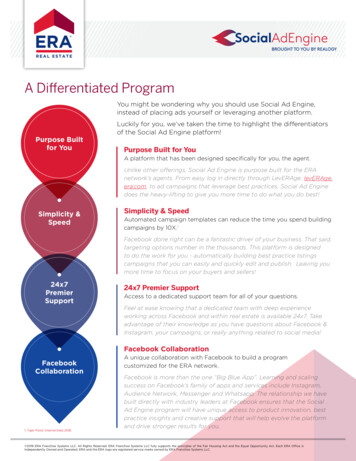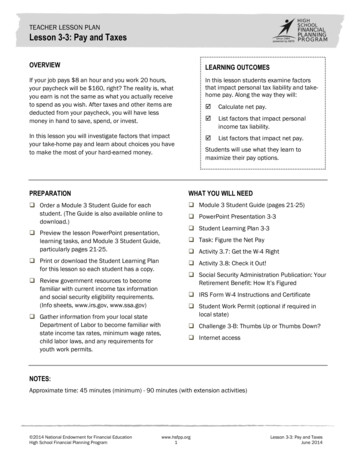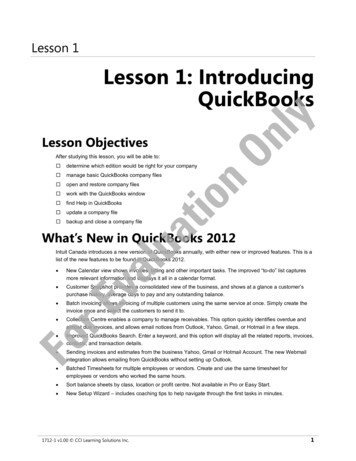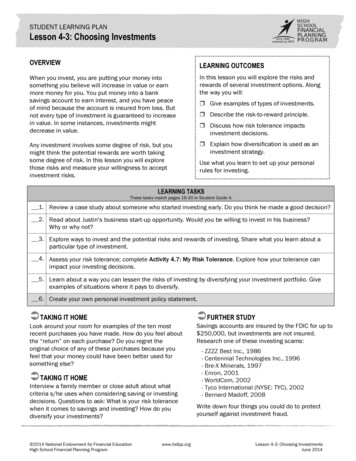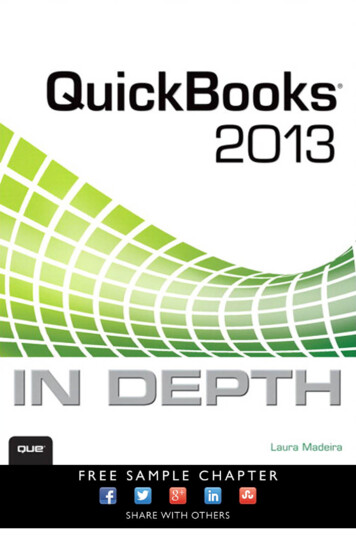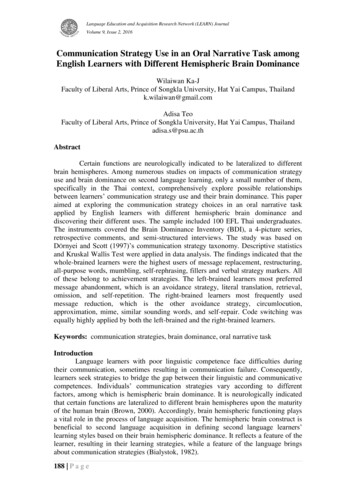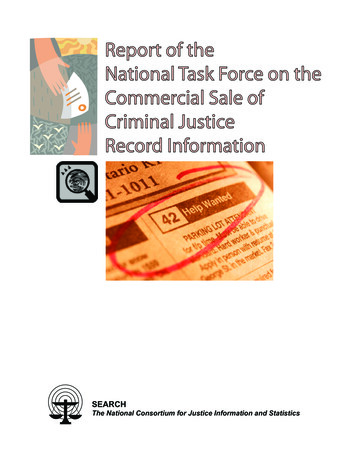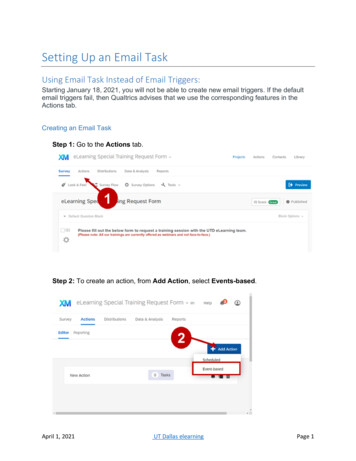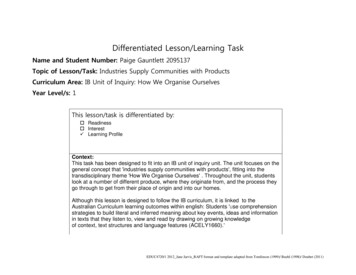
Transcription
Differentiated Lesson/Learning TaskName and Student Number: Paige Gauntlett 2095137Topic of Lesson/Task: Industries Supply Communities with ProductsCurriculum Area: IB Unit of Inquiry: How We Organise OurselvesYear Level/s: 1This lesson/task is differentiated by: Readiness Interest Learning ProfileContext:This task has been designed to fit into an IB unit of inquiry unit. The unit focuses on thegeneral concept that 'industries supply communities with products', fitting into thetransdisciplinary theme 'How We Organise Ourselves' . Throughout the unit, studentslook at a number of different produce, where they originate from, and the process theygo through to get from their place of origin and into our homes.Although this lesson is designed to follow the IB curriculum, it is linked to theAustralian Curriculum learning outcomes within english: Students 'use comprehensionstrategies to build literal and inferred meaning about key events, ideas and informationin texts that they listen to, view and read by drawing on growing knowledgeof context, text structures and language features (ACELY1660).'EDUC4720/1 2012 Jane Jarvis RAFT format and template adapted from Tomlinson (1999)/ Buehl (1998)/ Doubet (2011)
This lesson is found roughly in first half of the unit. Students have explored sequencingthe steps of other processes, such as eggs, as well as looked at different farms andfactories, and their role within society. The students are focusing on the production ofmilk for this lesson. After this lesson is completed, the students will begin looking atmore complex produce such as bread. The students will then complete a summativeassessment piece for the unit, which will involve them explaining the productionsequence of a product of their choice.Learning ObjectivesStudents will understand that:Farms and factories play an important role in providing shops and homes with produce.Students will know that:The origin of milk is from a cow.Milk goes through a process of sequential steps to get from a farm to our homes.Farm, product, process, milk, cattle, dairy, pasture, factory and transport is the specificvocabulary involved the production of milk.Students will be able to:Sequence the correct order of steps for the production of milk.EDUC4720/1 2012 Jane Jarvis RAFT format and template adapted from Tomlinson (1999)/ Buehl (1998)/ Doubet (2011)
Essential Questions:How does milk get from the cow to our homes?Would it be better if we each have a cow to get our own milk?What would happen if we didn't have cows?What would happen if there were no farmers?EDUC4720/1 2012 Jane Jarvis RAFT format and template adapted from Tomlinson (1999)/ Buehl (1998)/ Doubet (2011)
Differentiated “RAFT”Name and student #: Paige GauntlettRAFT Topic: The process of how milk gets from a cow to our homes.Curriculum Area: IB Unit of Inquiry: How We Organise OurselvesYear Level: 1Learning ObjectivesStudents will understand that:Farms and factories play an important role in providing homeswith produce.Students will know that:The origin of milk is from a cow.Milk goes through a process of sequential steps to get from afarm to our homes.Farm, product, process, milk, cattle, dairy, pasture, factory andtransport is the specific vocabulary involved the production ofmilk.Students will be able to:Sequence the correct order of steps for the production of milk.This RAFT is differentiated by: Readiness Interest Learning ProfileWithin this lesson, the RAFT is being used as a sense makingactivity. The purpose of the task is to further develop the studentsunderstanding. The students are still exploring the origins ofdifferent products and the steps taken to get these products fromtheir place of origin, into our homes. This lesson has beendesigned to broaden their knowledge and skills around thisconcept. Their work will also be collected at the end of the lessonfor formative assessment, to give the teacher an idea on howeach student is coming along with their understanding.EDUC4720/1 2012 Jane Jarvis RAFT format and template adapted from Tomlinson (1999)/ Buehl (1998)/ Doubet (2011)
How students’ work will be evaluatedWithin this RAFT, the students are taking on the same role andaudience. They are also focusing on the same topic. They aregiven the choice with their format. Within these choices of format,the students are still displaying the same learning outcomes (theycan sequence the steps of milk production in the correct order).The students will be formatively marked against a rubric (seeappendices 4).EDUC4720/1 2012 Jane Jarvis RAFT format and template adapted from Tomlinson (1999)/ Buehl (1998)/ Doubet (2011)
RAFT Title: Where does milk come from?ROLECowCowCowAUDIENCEChildren visitingthe farm.FORMATTOPICVoice ThreadHow milk getsfrom a cow to ourhomesChildren visitingthe farm.Match andHow milk getsSequence Photos from a cow to ourand SentenceshomesChildren visitingthe farm.How milk getsfrom a cow to ourhomesDraw and writethe stepsEDUC4720/1 2012 Jane Jarvis RAFT format and template adapted from Tomlinson (1999)/ Buehl (1998)/ Doubet (2011)
Preassessment of Students’ ReadinessA students readiness refers to their prior knowledge, understanding, skills andexperiences in relation to a specific set of objectives for a lesson or unit of work.A students readiness changes overtime. It is important that teachers are aware ofeach students readiness, in relation to each lesson and that lessons learningobjectives (knowledge, skills and able to do). (Jarvis, 2014). For this lesson usinga RAFT, the teacher is aware of each students readiness level throughobservations and formative assessment within the unit so far. This also refers toeach students learning profile. The teacher is aware of these throughobservations and previous formative assessments in their classroom.Lesson PlanLesson SequenceExplanatory notesIntroductionStudents will gather on the floor.Students will have a brief discussionabout what they did in their last UOIlesson (looking at the production oftomatoes).As a class, the teacher will then readbig book 'How Cows Make Milk', byKatherine A. Smith. Whilst reading thebook, discuss the different steps of milkproduction outlined in the book.It is important that at the beginning of every lessonthat the teacher and students go over what they didlast lesson. This will stimulate the students thinkingand working memory (Jarvis, 2014).Students have read this book once before in anenglish lesson and discussed the different steps inthe production of milk (looking at informationreports). Therefore, they are familiar with thisprocess. They are re-reading the book to go overtheir learning, as well as help clarify any questionsstudents may have about the process, and to helpthose students who may need more time to processthe information.EDUC4720/1 2012 Jane Jarvis RAFT format and template adapted from Tomlinson (1999)/ Buehl (1998)/ Doubet (2011)
Guided DiscoveryThe teacher will explain the RAFT tothe students again. This is will be ageneral explanation. The students willhave their chosen format explained inmore detail in their groups.Teacher: Each of you are going topretend you are a cow on a farm. Agroup of school children are visitingyour farm and it is your job to explain ortell the children how milk gets fromcows to our homes. You have 3different ways you can explain this tothe children, and you are able to pickone. You can do a voice thread, matchsome photos and sentences, and putthese into the correct order, or you candraw and write the correct steps. Thosewanting to do a voice thread, make agroup near the white board. Thosewanting to match photos andsentences, make a group near themaths shelf, and those wanting to drawand write the steps, make a group nearthe library corner.RAFT is an acronym, that stands for Role, Audience,Format, Topic. A RAFT can be designed in anumber ways, to differentiate within a classroom andto respond to student differences (Tomlinson, 2003).This RAFT has been designed to cater for differentstudents learning profiles. A students learning profilerefers to the way the students like to learn, and theways they like to express their learning. A studentslearning profile is shaped by the their past and priorexperiences outside the classroom (McFarlane,2014). It must be noted that a students learningprofile is different from their interest. A studentsinterest refers to the topics they are interested in,where as a students learning profile refers to theways of working with information (Jarvis, 2014).The RAFT that has been designed represents adifferentiated learning task, as it is giving studentschoice in the format they choose to present theirinformation, hence catering for different studentslearning profiles. Although they are all the same role,speaking to the same audience, about the sametopic, they are given the opportunity to choose theformat in which they present their information.Accommodating for different student learningprofiles, and therefore differentiating within theclassroom has a number of benefits for students.Not only does it help motivate and engage students,but it also gives them the opportunity to take someresponsibility for their own leaning. This in turnencourages students to take pride in their work andtheir own progress, rather than competing with theirpeers work(Jarvis, 2014).Students will get into their chosenEDUC4720/1 2012 Jane Jarvis RAFT format and template adapted from Tomlinson (1999)/ Buehl (1998)/ Doubet (2011)
group. The teacher will go to eachgroup and explain their particular taskin more detail. Whilst the other groupswait for their instructions, they will beasked to look at a teacher exempladone using the same format they havechosen, on the production of eggs(previously studied) and to formulateany questions they may have abouttheir task for the teacher.The teacher will move to each group,explaining their task:Voice Thread:You will be given some photos of thesteps to get milk from a cow to ourhomes that you need to put in order onyour voice thread (see appendices 1).You then need to say what ishappening in each of these photos andrecord yourself (show students theteacher exempla with the production ofeggs on IWB). Answer any questions.Drawing and WritingYou will be given a sheet(seeappendices 3) with empty boxes on it.Your task is to draw the steps of howwe get milk from a cow to our homesEDUC4720/1 2012 Jane Jarvis RAFT format and template adapted from Tomlinson (1999)/ Buehl (1998)/ Doubet (2011)
and to write a sentence underneathabout what is happening in each box(show students the teacher exemplawith the production of eggs). Answerany student questions.Photos and SentencesYou will be given some photos of thesteps on how milk gets from a cow toour homes (see appendices 1). Youneed to put these in the correct order.You will also be given some sentencesthat explain what is happening in eachof the photos (see appendices 2). Youneed to match these sentences up withtheir photo (show students the teacherexempla with the production of eggs).out the sentences. Answer any studentquestions.By this stage, all students will be backat their desks working on their tasks.Once the final RAFT strip has beenexplained to the students, askstudents: give me a thumbs up if youknow what you have to do, a thumb tothe side if your still not sure or athumbs down if you still have no ideaand still need a bit of help.Even though the RAFT has been explained, andexemplas given, there will still be some students thatneed further clarification. It is important that whenstudents are asked to do a task, that theyunderstand what they have to do and that theteacher ensures they are supporting their studentsand giving them that extra clarification to do so. Thiswill help to develop a positive and safe learningenvironment, a key principal of differentiationEDUC4720/1 2012 Jane Jarvis RAFT format and template adapted from Tomlinson (1999)/ Buehl (1998)/ Doubet (2011)
The students who give a thumbs a upcan continue working.Those students who still need someclarification, gather them on the floorand clarify any questions. Parts of theRAFT may need explaining again(McFarlane, 2014). Therefore, the students aregiven the opportunity to go through the designedtask again.Since the students are only year one and are stilldeveloping their reading skills, they will not beprovided with task cards since they would havedifficulty reading them.ExplorationStudents complete their chosen taskfrom the RAFT. To challenge andsupport readiness, the teacher willprovide each format with a number ofstrategies. These include:Voice Thread: As already mentioned, there isan exemplar made by theteacher that students can referback to (using egg production). Word prompts of the specificvocabulary they can use toassist students. Sentence starters to assiststudents. Questions to further stimulatethinking. Hint Cards Folder: Students canThe students have used voice thread before.Therefore, most students are aware of how theprogram operates and will be able to utilise theprogram using ipads if they choose this format.However, some students will need clarification ofthis. The teacher will hold a small group on the floorand will go through the program is this is the case.Students need to be presented with the right amountof challenge to have successful learningexperiences. If a task is to easy or difficult for astudent, they will lose interest and motivation, hencelearning will not take place. This refers to VygotskysZone of Proximal Development. If students arepresented with tasks that are challenging, but withintheir reach, they will be motivated and willing tolearn. (Jarvis, 2014). Therefore, each task within theRAFT has been provided with a number of differentEDUC4720/1 2012 Jane Jarvis RAFT format and template adapted from Tomlinson (1999)/ Buehl (1998)/ Doubet (2011)
go to this folder which will givethem hints to guide their task.Photos and Se
For this lesson using a RAFT, the teacher is aware of each students readiness level through observations and formative assessment within the unit so far. This also refers to each students learning profile. The teacher is aware of these through observations and previous formative assessments in their classroom. Lesson Plan Lesson Sequence Introduction Students will gather on the floor. Students .
